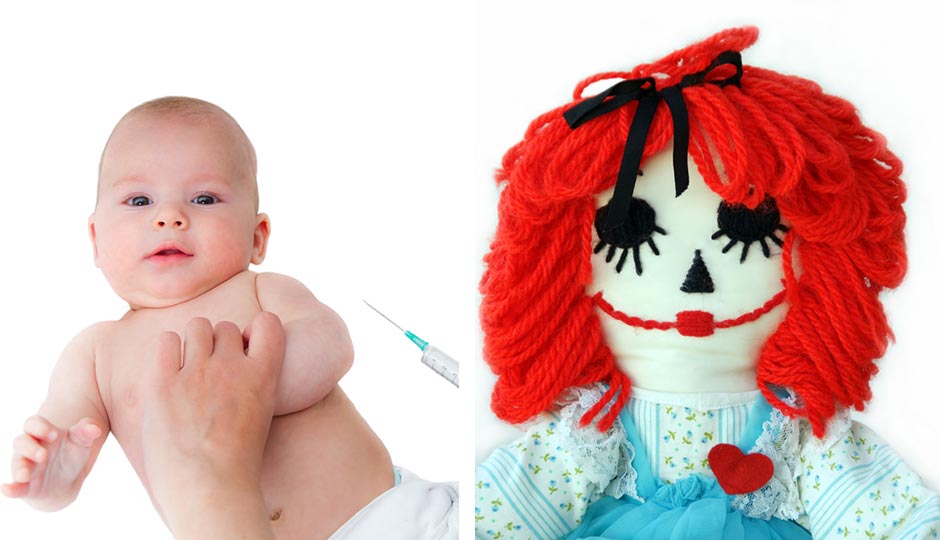The Strange Link Between Raggedy Ann and the Anti-Vaxxers
What's the world's most famous rag doll got to do with vaccinations and death?
Over the weekend I was reading a story in the Wall Street Journal about the history of the anti-vaccination movement when I came across a familiar name: Raggedy Ann. Here’s what the author, NYU historian David Oshinsky, had to say:
Historians generally trace the anti-vaccine movement to a number of 19th-century groups, including religious activists, radical libertarians and health faddists, who insisted that [Edward] Jenner’s vaccine actually caused smallpox. Like some current movement activists, these early leaders had a personal story to tell, claiming that a vaccine had harmed or even killed someone close to them, most often a child. Indeed, their most visible symbol was the smiling but entirely limp Raggedy Ann doll created by a popular cartoonist for his daughter, who had fallen ill and would later die, he believed, from a smallpox shot she received without his permission.
I didn’t have a Raggedy Ann doll when I was little, but I had Raggedy Ann books, written and illustrated by one Johnny Gruelle. The one I especially remember was called Raggedy Ann’s Lucky Pennies. What I mostly remember about it was that it was dark and deeply weird. I looked it up on Amazon and found this synopsis:
When Raggedy Ann and Andy pick a lucky penny from the Lucky Penny Tree, they have no idea that it will lead them to all sorts of new friends and adventures! Right after they meet a prince who has lost his memory, they are captured by the wicked King Growch, who locks them up in his prison coop. They escape thanks to Lovey Lou and Ponko the puppy dog, and soon learn that there is a mystery at the King’s castle — and a missing prince. With the help of two nice witches, lots of wonderful friends, and their own wishing magic, the Raggedys do their very best to solve the mystery and restore happiness to the whole kingdom.
Yeah, that’s what I remember: a sort of fever-dream of a book with weird, creepy characters making unexpected entrances and exits, and Raggedy Ann and her brother cheerily taking it all in stride while they smiled and loved everyone from the depths of their candy hearts. So — what did any of that have to do with vaccines?
It seems a lot of half-truths and rumors have gotten conflated in the story of Johnny Gruelle and Raggedy Ann. Here’s how the tale goes on his Wikipedia page:
Gruelle gave his daughter Marcella a dusty, faceless rag doll which she found in the attic. He drew a face on the doll and named her Raggedy Ann. Marcella played with the doll so much, Gruelle figured other children would like the doll too. Gruelle’s Raggedy Ann doll U.S. Patent D47,789 was dated September 7, 1915. In 1918, the PF Volland Company published Raggedy Ann Stories. Gruelle then created a series of popular Raggedy Ann books and dolls. …
Marcella Gruelle contracted diphtheria and died at the age of 13. After this blow, family friends described Gruelle as “possessed, with a heavy countenance, and … with the only thing he would bear to have near him as a reminder of Marcella a rag doll.
But a story on the debunking site Snopes tells it differently:
In 1921, Johnny Gruelle’s 8-yr old daughter was vaccinated in school
without her parents’ permission. Between the time she became ill from the
vaccination and her death a few months later, her body was completely
limp, like a rag doll. It was this sick vaccine-injured child that
inspired Gruelle to create the Raggedy Ann doll.
That’s really creepy. No wonder the books were dark!
But according to the DollKind doll-history website, neither account is strictly true. Johnny Gruelle did have a daughter named Marcella, who died at age 13, not eight. Gruelle did find the doll in the attic, and drew a face on it. Marcella was vaccinated against smallpox at school, without Gruelle’s explicit permission (the shots were mandatory), and she subsequently died of an infection. But Gruelle took out a patent for the character shortly after Marcella’s death, which DollKind says shows he was already working on the concept. And while he did become a vocal opponent of vaccinations, he himself didn’t connect the doll with the movement. That seems to have been the work of later anti-vaxxers.
My own daughter had a Raggedy Ann doll but didn’t much play with it. I think perhaps she picked up on my ambivalence about those books I’d read as a kid. Or maybe she just liked breasty old Barbie better than a limp candy-hearted friend. Whatever the truth of the connections between Raggedy Ann and Marcella Gruelle and her heartbroken father, it’s a strange tale — and a reminder, like the WSJ piece, of how far back the anti-vaccine movement reaches into the past.
Follow @SandyHingston on Twitter.



